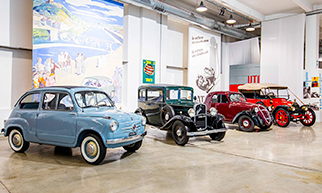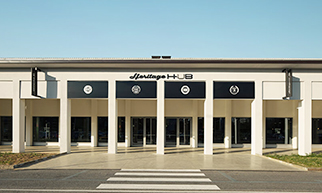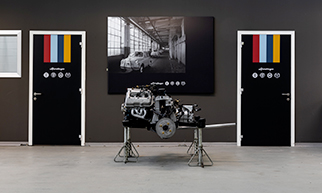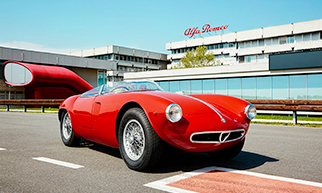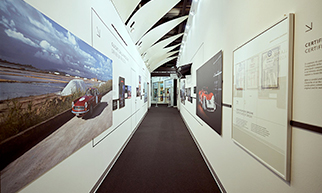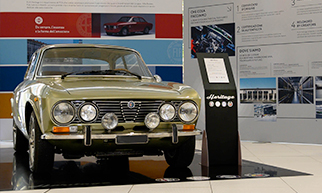A smaller-scale version of the innovative Aprilia, the small Lancia offered a bold and modern design flanked by particularly sophisticated mechanics. Compact, functional and at the same time elegant, it also proved to be particularly efficient and economical in consumption.
For the Turin-based company, the idea of producing two very similar cars, the second the slightly smaller-scale version of the first, began in the early 1930s with the Artena and Astura. A few years later, in 1939, it was repeated with the Ardea, alongside the revolutionary Lancia Aprilia.
The historical context, as World War II beckoned, led Vincenzo Lancia to also think of a car that could be more accessible than the still-developing Aprilia, without sacrificing innovative concepts and stylistic features. At that time, Italy was paying heavy economic sanctions that weighed on the import of raw materials from abroad, from steel to aluminium as well as fuels, all as a result of its invasion of Ethiopia.
In the mind of “Monsù” Lancia, Ardea was to become the most popular car he produced. His untimely death, on 15 February 1937, meant he could never see the Aprilia enter into production. For everyone, it became his spiritual testament, but nor did he follow up on the Ardea project: it was his wife Adele who took the reins of the company and brought both new Lancias to their debut, at different times.
The lines of the Aprilia and Ardea were both inspired by the streamline design in vogue at the time in the States, a movement between engineering and art that laid out sinuous and aerodynamic lines borrowed from aeroplanes and re-proposed in trains and cars to increase their performance, significantly influencing stylistic features. Interpreting those dictates, then without the scientific certification offered by wind tunnels but in any case studied with the contribution of the Polytechnic University of Turin, the overall shape can be circumscribed by an egg, then considered the most efficient aerodynamic shape. It should be emphasised, however, that such an innovative design was not only functional, but was aimed at becoming a symbol of modernity.
However we look at the two cars, we can see the similarities: the badge radiator delineates the grille with teardrop headlights on the fenders surrounding the bonnet, the sloping windscreen, and on the sides the characteristic doors with invisible hinges and wardrobe opening without a central pillar. The rear was strongly tapered by the continuous curvature that began from the roof and ended in the bumper at the bottom, emphasising the curvature of the rear fenders. Above all, the common thread shared by the Aprilia and Ardea was the architecture of the body which, as with all Lancias starting with the Lambda, was load-bearing and did not therefore require a traditional frame.
Conversely, there were differences, not only in the Ardea's dimensions: these started with the bonnet hinged under the windscreen to move the grille upwards as well, therefore no longer a ‘butterfly’ with two distinct elements as previously and in the Aprilia. In the rear, the boot could not be opened from the outside; instead, it could be accessed by lowering the backrest of the rear seats, with the only small opening behind the licence plate providing access to the spare wheel and tools for minor maintenance. In the first series, the rear window was divided in two.
The only components in common with the Aprilia engine were the four cylinders and the narrow V architecture, although the Ardea unit was characterised by an original and innovative system using a single camshaft for distribution. This was the implementation of one of the latest patents resulting from the genius of Vincenzo Lancia and his staff. Located on the cylinder head and set in motion by a chain with an automatic tensioner, the shaft acted on the valves through Z-shaped rocker arms. The combustion chambers were hemispherical, a solution considered the best at the time, with the two valves per cylinder oriented so they could be reached by the original rocker arms. The displacement was very limited: 903 cc, to deliver up to 28 hp. Although not a high output, this was still enough to push the small Lancia above 105 km/h (108 in the first series).
Among the idiosyncrasies of the compact narrow V-shaped engine was the tappet cover, particularly contained as a result of the original distribution system: it was produced in a synthetic “Made in Italy” material to save on the use of metals. The overall standout feature, however, was its efficiency that resulted in very low consumption for the time: 7.5 litres per 100 km, a non-negligible detail when considering the difficulty of refuelling during the War. Plus, with the customary attention to the comfort of Lancia cars, the engine was anchored to the body with tiny cantilever leaf springs to absorb vibrations.
Roominess and ease of access were among its strengths from the outset, whereas during its development the mechanics became more and more sophisticated: small does not only mean cheaper; on the contrary.
The compactness of the engine, initially coupled to the four-speed gearbox, meant it could be placed in an almost cantilevered position with respect to the front axle, all to the advantage of space for four people in the passenger compartment. The independent front suspension followed the sophisticated Aprilia scheme while, in this case also to reduce costs, there was a rigid axle suspended from leaf springs on the rear axle. The passenger compartment, due to the different tapering at the rear, was even slightly more spacious than its forerunner’s, again with the characteristic access facilitated by the wardrobe opening due to the absence of the central pillar.
With the inevitable interruption during the War, the production of the Lancia Ardea, which began in the early 1940s, was divided into four series: in the first, alongside the sedan (also known as the 250), some chassis for coachbuilders (350) were produced, but above all a version with an extended wheelbase and seven seats, known as Taxi Roma (450). The second series followed the first and focused only on the production of the saloon car.
From 1945 to 1953 the third and fourth series were produced, characterised by the adoption of a new door to open the boot and single-glazed rear window. The mechanics were embellished with the 12-volt electrical system but above all with a five-speed gearbox, a world-first mechanical refinement for a non-sports car with under one litre of displacement. With the fourth series came the adoption of the new aluminium cylinder head which, with other improvements, took the output to 30 hp and top speed to 110 km/h. Some 350 chassis continued to be produced, then curiously two new versions – the 550 and 650 – began production, respectively a small van and small lorry, which were definitely not fast but unusually elegant, intended for relaunch immediately after WW2.
The Lancia Ardea was not intended for sporting ambitions, as well as the fact that its launch coincided with WW2 meant that fewer gentlemen drivers were taking it on. The crew of Coda & Damma in 1947, in the first post-war edition of the Mille Miglia, remains relevant. With 26th place overall Mario Coda, who had already raced in previous editions at the wheel of a Lancia Lambda, won the Class up to 1,100 cc with the small Ardea, beating a bevy of Fiat 1,100 clearly favoured for its higher displacement.
The motivations that led to the creation of sister cars at the time were not only to be found in the economy of scale to share components, but rather in Lancia's desire to offer customers high quality, technical, material and construction, providing them with the same characteristics in cars belonging to different segments. Smaller did not only mean cheaper, but so much more, as shown by the innovative distribution system and the adoption of a five-speed gearbox. Only later, with the greater industrialisation of production in the 1960s – always very precise but less artisan – many more components with economic advantages were shared, that benefit highly coveted at the time, as seen in the siblings Lancia Flavia and Fulvia.
Not only for its compactness, a Lancia Ardea is on display in the Small & Safe section at the Stellantis Heritage Hub in Turin. Vincenzo Lancia, before many other manufacturers of the time, had shown himself attentive to the protection of occupants in the event of accidents, beginning with the Lancia Augusta in the early 1930s. The load-bearing body, made of welded and moulded panels, formed a structural shell in which the passenger compartment became the forerunner of the safety cells gradually perfected subsequently.
